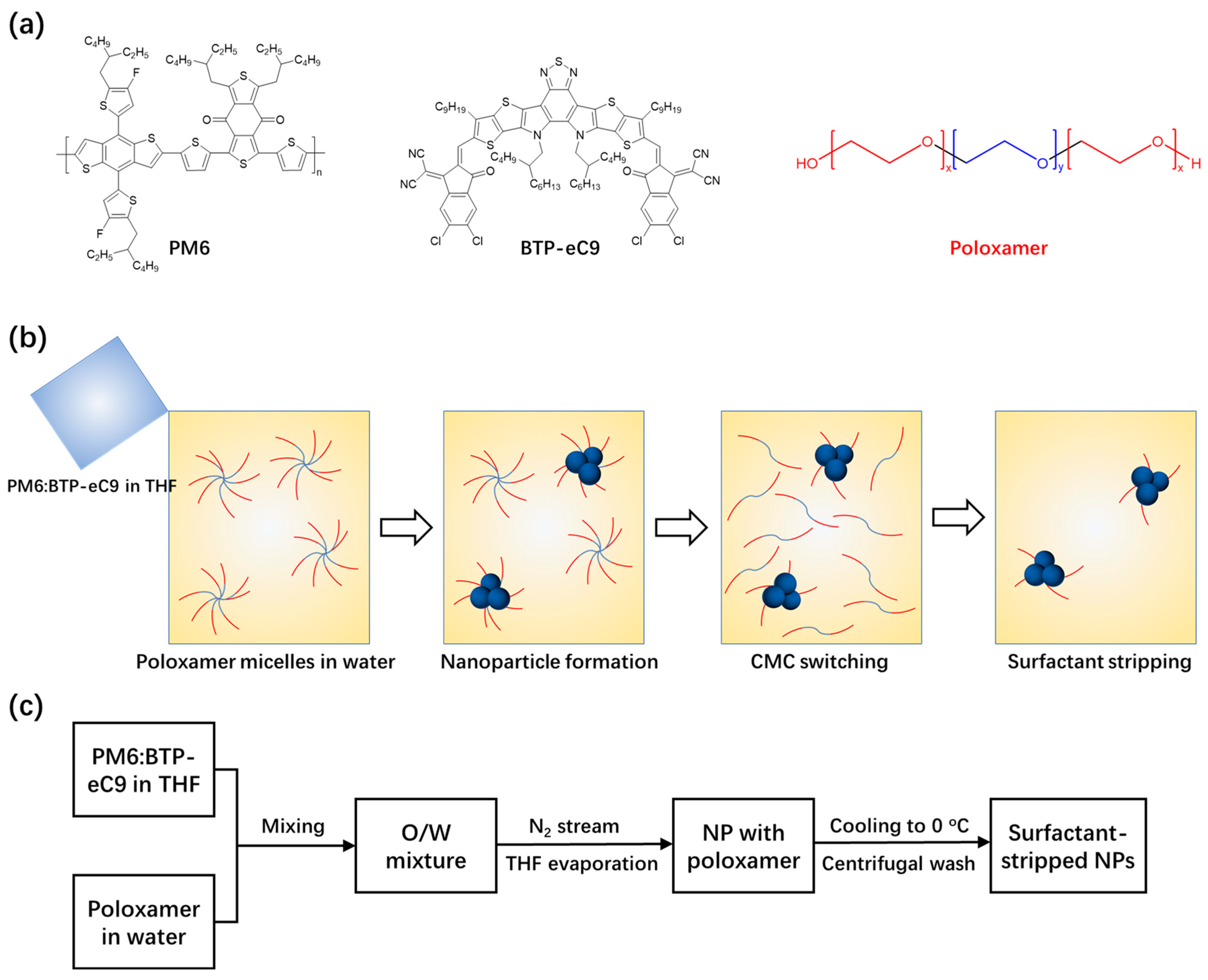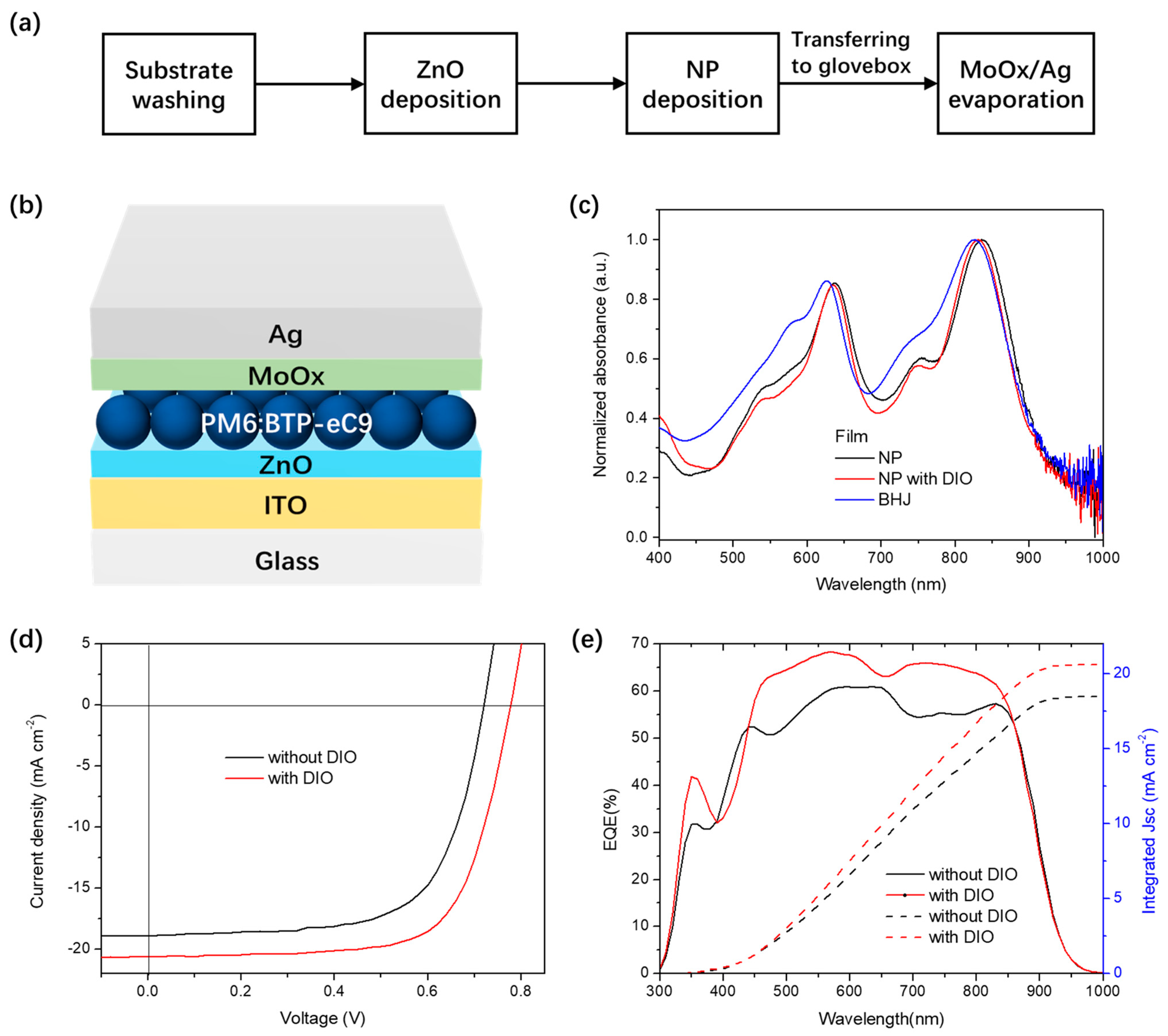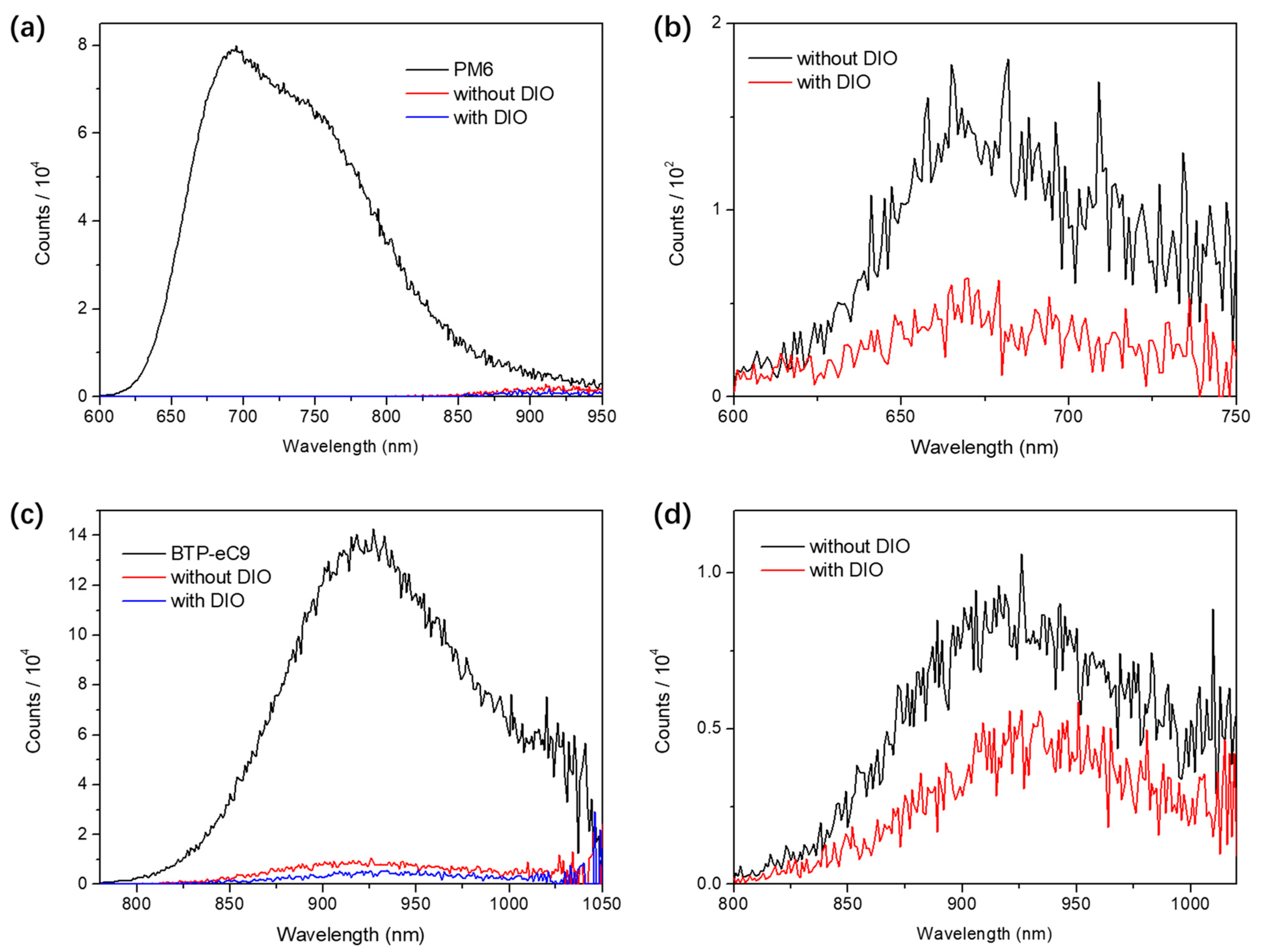Water−Processed Organic Solar Cell with Efficiency Exceeding 11%
Abstract
:1. Introduction
2. Materials and Methods
2.1. Materials
2.2. NP Synthesis
2.3. Poloxamer Quantification
2.4. Characterization
2.5. Solar Cell Fabrication and Characterization
2.6. Space−Charge−Limited−Current (SCLC)
3. Results and Discussions
3.1. Syhthesis of Surfactant−Stripped NPs
3.2. Solar Cell Characterization
3.3. Device Physics Analysis
4. Conclusions
Supplementary Materials
Author Contributions
Funding
Institutional Review Board Statement
Informed Consent Statement
Data Availability Statement
Acknowledgments
Conflicts of Interest
References
- Mazzio, K.A.; Luscombe, C.K. The Future of Organic Photovoltaics. Chem. Soc. Rev. 2015, 44, 78–90. [Google Scholar] [CrossRef] [PubMed]
- Kaltenbrunner, M.; White, M.S.; Głowacki, E.D.; Sekitani, T.; Someya, T.; Sariciftci, N.S.; Bauer, S. Ultrathin and Lightweight Organic Solar Cells with High Flexibility. Nat. Commun. 2012, 3, 770. [Google Scholar] [CrossRef] [Green Version]
- Zhu, L.; Zhang, M.; Xu, J.; Li, C.; Yan, J.; Zhou, G.; Zhong, W.; Hao, T.; Song, J.; Xue, X.; et al. Single−Junction Organic Solar Cells with over 19% Efficiency Enabled by a Refined Double−Fibril Network Morphology. Nat. Mater. 2022, 21, 656–663. [Google Scholar] [CrossRef]
- Cui, Y.; Xu, Y.; Yao, H.; Bi, P.; Hong, L.; Zhang, J.; Zu, Y.; Zhang, T.; Qin, J.; Ren, J.; et al. Single−Junction Organic Photovoltaic Cell with 19% Efficiency. Adv. Mater. 2021, 33, 2102420. [Google Scholar] [CrossRef]
- Zhang, J.; Zhu, L.; Wei, Z. Toward Over 15% Power Conversion Efficiency for Organic Solar Cells: Current Status and Perspectives. Small Methods 2017, 1, 1700258. [Google Scholar] [CrossRef]
- Che, X.; Li, Y.; Qu, Y.; Forrest, S.R. High Fabrication Yield Organic Tandem Photovoltaics Combining Vacuum− and Solution−Processed Subcells with 15% Efficiency. Nat. Energy 2018, 3, 422–427. [Google Scholar] [CrossRef]
- Henderson, R.K.; Jiménez−González, C.; Constable, D.J.C.; Alston, S.R.; Inglis, G.G.A.; Fisher, G.; Sherwood, J.; Binks, S.P.; Curzons, A.D. Expanding GSK’s Solvent Selection Guide—Embedding Sustainability into Solvent Selection Starting at Medicinal Chemistry. Green Chem. 2011, 13, 854–862. [Google Scholar] [CrossRef]
- Han, J.; Kiss, L.; Mei, H.; Remete, A.M.; Ponikvar−Svet, M.; Sedgwick, D.M.; Roman, R.; Fustero, S.; Moriwaki, H.; Soloshonok, V.A. Chemical Aspects of Human and Environmental Overload with Fluorine. Chem. Rev. 2021, 121, 4678–4742. [Google Scholar] [CrossRef] [PubMed]
- Duan, C.; Zhang, K.; Zhong, C.; Huang, F.; Cao, Y. Recent Advances in Water/Alcohol−Soluble π−Conjugated Materials: New Materials and Growing Applications in Solar Cells. Chem. Soc. Rev. 2013, 42, 9071–9104. [Google Scholar] [CrossRef] [PubMed]
- Søndergaard, R.; Helgesen, M.; Jørgensen, M.; Krebs, F.C. Fabrication of Polymer Solar Cells Using Aqueous Processing for All Layers Including the Metal Back Electrode. Adv. Energy Mater. 2011, 1, 68–71. [Google Scholar] [CrossRef]
- Duan, C.; Cai, W.; Hsu, B.B.Y.; Zhong, C.; Zhang, K.; Liu, C.; Hu, Z.; Huang, F.; Bazan, G.C.; Heeger, A.J.; et al. Toward Green Solvent Processable Photovoltaic Materials for Polymer Solar Cells: The Role of Highly Polar Pendant Groups in Charge Carrier Transport and Photovoltaic Behavior. Energy Environ. Sci. 2013, 6, 3022–3034. [Google Scholar] [CrossRef]
- Zappia, S.; Scavia, G.; Ferretti, A.M.; Giovanella, U.; Vohra, V.; Destri, S. Water−Processable Amphiphilic Low Band Gap Block Copolymer:Fullerene Blend Nanoparticles as Alternative Sustainable Approach for Organic Solar Cells. Adv. Sustain. Syst. 2018, 2, 1700155. [Google Scholar] [CrossRef]
- Diterlizzi, M.; Ferretti, A.M.; Scavia, G.; Sorrentino, R.; Luzzati, S.; Boccia, A.C.; Scamporrino, A.A.; Po’, R.; Quadrivi, E.; Zappia, S.; et al. Amphiphilic PTB7−Based Rod−Coil Block Copolymer for Water−Processable Nanoparticles as an Active Layer for Sustainable Organic Photovoltaic: A Case Study. Polymers 2022, 14, 1588. [Google Scholar] [CrossRef] [PubMed]
- Vohra, V.; Shimizu, S.; Takeoka, Y. Water−Processed Organic Solar Cells with Open−Circuit Voltages Exceeding 1.3V. Coatings 2020, 10, 421. [Google Scholar] [CrossRef]
- Xie, C.; Heumüller, T.; Gruber, W.; Tang, X.; Classen, A.; Schuldes, I.; Bidwell, M.; Späth, A.; Fink, R.H.; Unruh, T.; et al. Overcoming Efficiency and Stability Limits in Water−Processing Nanoparticular Organic Photovoltaics by Minimizing Microstructure Defects. Nat. Commun. 2018, 9, 5335. [Google Scholar] [CrossRef] [PubMed] [Green Version]
- Xie, C.; Classen, A.; Späth, A.; Tang, X.; Min, J.; Meyer, M.; Zhang, C.; Li, N.; Osvet, A.; Fink, R.H.; et al. Overcoming Microstructural Limitations in Water Processed Organic Solar Cells by Engineering Customized Nanoparticulate Inks. Adv. Energy Mater. 2018, 8, 1702857. [Google Scholar] [CrossRef]
- Xie, C.; Tang, X.; Berlinghof, M.; Langner, S.; Chen, S.; Späth, A.; Li, N.; Fink, R.H.; Unruh, T.; Brabec, C.J. Robot−Based High−Throughput Engineering of Alcoholic Polymer: Fullerene Nanoparticle Inks for an Eco−Friendly Processing of Organic Solar Cells. ACS Appl. Mater. Interfaces 2018, 10, 23225–23234. [Google Scholar] [CrossRef] [PubMed]
- Snaith, H.J.; Friend, R.H. Photovoltaic Devices Fabricated from an Aqueous Dispersion of Polyfluorene Nanoparticles Using an Electroplating Method. Synth. Met. 2004, 147, 105–109. [Google Scholar] [CrossRef]
- Colberts, F.J.M.; Wienk, M.M.; Janssen, R.A.J. Aqueous Nanoparticle Polymer Solar Cells: Effects of Surfactant Concentration and Processing on Device Performance. ACS Appl. Mater. Interfaces 2017, 9, 13380–13389. [Google Scholar] [CrossRef] [Green Version]
- Cho, J.; Yoon, S.; Min Sim, K.; Jin Jeong, Y.; Eon Park, C.; Kwon, S.K.; Kim, Y.H.; Chung, D.S. Universal Selection Rule for Surfactants Used in Miniemulsion Processes for Eco−Friendly and High Performance Polymer Semiconductors. Energy Environ. Sci. 2017, 10, 2324–2333. [Google Scholar] [CrossRef]
- Marks, M.; Holmes, N.P.; Sharma, A.; Pan, X.; Chowdhury, R.; Barr, M.G.; Fenn, C.; Griffith, M.J.; Feron, K.; Kilcoyne, A.L.D.; et al. Building Intermixed Donor−Acceptor Architectures for Water−Processable Organic Photovoltaics. Phys. Chem. Chem. Phys. 2019, 21, 5705–5715. [Google Scholar] [CrossRef] [Green Version]
- Cho, J.; Cheon, K.H.; Ahn, H.; Park, K.H.; Kwon, S.K.; Kim, Y.H.; Chung, D.S. High Charge−Carrier Mobility of 2.5 cm2 V−1 s−1 from a Water−Borne Colloid of a Polymeric Semiconductor via Smart Surfactant Engineering. Adv. Mater. 2015, 27, 5587–5592. [Google Scholar] [CrossRef]
- Cui, Y.; Yao, H.; Zhang, J.; Xian, K.; Zhang, T.; Hong, L.; Wang, Y.; Xu, Y.; Ma, K.; An, C.; et al. Single−Junction Organic Photovoltaic Cells with Approaching 18% Efficiency. Adv. Mater. 2020, 32, 1908205. [Google Scholar] [CrossRef]
- Yu, Y.Y.; Shih, K.Y.; Peng, Y.C.; Chiu, Y.C.; Kuo, C.C.; Yang, C.C.; Chen, C.P. High−Efficiency Organic Photovoltaic Cells Processed Using a Non−Halogen Solvent. Mater. Chem. Phys. 2022, 282, 125971. [Google Scholar] [CrossRef]
- Yuan, J.; Zhang, Y.; Zhou, L.; Zhang, G.; Yip, H.L.; Lau, T.K.; Lu, X.; Zhu, C.; Peng, H.; Johnson, P.A.; et al. Single−Junction Organic Solar Cell with over 15% Efficiency Using Fused−Ring Acceptor with Electron−Deficient Core. Joule 2019, 3, 1140–1151. [Google Scholar] [CrossRef]
- Zhang, Y.; Jeon, M.; Rich, L.J.; Hong, H.; Geng, J.; Zhang, Y.; Shi, S.; Barnhart, T.E.; Alexandridis, P.; Huizinga, J.D.; et al. Non−Invasive Multimodal Functional Imaging of the Intestine with Frozen Micellar Naphthalocyanines. Nat. Nanotechnol. 2014, 9, 631–638. [Google Scholar] [CrossRef]
- Ahmed, F.; Alexandridis, P.; Neelamegham, S. Synthesis and Application of Fluorescein−Labeled Pluronic Block Copolymers to the Study of Polymer−Surface Interactions. Langmuir 2001, 17, 537–546. [Google Scholar] [CrossRef]
- Blom, P.W.M.; De Jong, M.J.M.; Vleggaar, J.J.M. Electron and Hole Transport in Poly(p−Phenylene Vinylene) Devices. Appl. Phys. Lett. 1996, 68, 3308–3310. [Google Scholar] [CrossRef] [Green Version]
- Chandaroy, P.; Sen, A.; Alexandridis, P.; Hui, S.W. Utilizing Temperature−Sensitive Association of Pluronic F−127 with Lipid Bilayers to Control Liposome−Cell Adhesion. Biochim. Biophys. Acta Biomembr. 2002, 1559, 32–42. [Google Scholar] [CrossRef] [Green Version]
- Bohorquez, M.; Koch, C.; Trygstad, T.; Pandit, N. A Study of the Temperature−Dependent Micellization of Pluronic F127. J. Colloid Interface Sci. 1999, 216, 34–40. [Google Scholar] [CrossRef]
- Alargova, R.G.; Deguchi, S.; Tsujii, K. Stable Colloidal Dispersions of Fullerenes in Polar Organic Solvents. J. Am. Chem. Soc. 2001, 123, 10460–10467. [Google Scholar] [CrossRef]
- Gärtner, S.; Christmann, M.; Sankaran, S.; Röhm, H.; Prinz, E.M.; Penth, F.; Pütz, A.; Türeli, A.E.; Penth, B.; Baumstümmler, B.; et al. Eco−Friendly Fabrication of 4% Efficient Organic Solar Cells from Surfactant−Free P3HT:ICBA Nanoparticle Dispersions. Adv. Mater. 2014, 26, 6653–6657. [Google Scholar] [CrossRef]
- Prunet, G.; Parrenin, L.; Pavlopoulou, E.; Pecastaings, G.; Brochon, C.; Hadziioannou, G.; Cloutet, E. Aqueous PCDTBT:PC71 BM Photovoltaic Inks Made by Nanoprecipitation. Macromol. Rapid Commun. 2018, 39, 1700504. [Google Scholar] [CrossRef]
- Ulum, S.; Holmes, N.; Barr, M.; Kilcoyne, A.L.D.; Gong, B.B.; Zhou, X.; Belcher, W.; Dastoor, P. The Role of Miscibility in Polymer: Fullerene Nanoparticulate Organic Photovoltaic Devices. Nano Energy 2013, 2, 897–905. [Google Scholar] [CrossRef]
- Jiang, H.; Qin, G.; Zhang, L.; Pan, F.; Wu, Z.; Wang, Q.; Wen, G.; Zhang, W.; Cao, Y.; Chen, J. Dithienobenzoxadiazole−Based Wide Bandgap Donor Polymers with Strong Aggregation Properties for the Preparation of Efficient as−Cast Non−Fullerene Polymer Solar Cells Processed Using a Non−Halogenated Solvent. J. Mater. Chem. C 2021, 9, 249–259. [Google Scholar] [CrossRef]
- Du, X.; Heumueller, T.; Gruber, W.; Almora, O.; Classen, A.; Qu, J.; He, F.; Unruh, T.; Li, N.; Brabec, C.J. Unraveling the Microstructure−Related Device Stability for Polymer Solar Cells Based on Nonfullerene Small−Molecular Acceptors. Adv. Mater. 2020, 32, 1908305. [Google Scholar] [CrossRef] [Green Version]
- Cowan, S.R.; Roy, A.; Heeger, A.J. Recombination in Polymer−Fullerene Bulk Heterojunction Solar Cells. Phys. Rev. B 2010, 82, 245207. [Google Scholar] [CrossRef] [Green Version]
- Proctor, C.M.; Kim, C.; Neher, D.; Nguyen, T.Q. Nongeminate Recombination and Charge Transport Limitations in Diketopyrrolopyrrole−Based Solution−Processed Small Molecule Solar Cells. Adv. Funct. Mater. 2013, 23, 3584–3594. [Google Scholar] [CrossRef]
- Brenner, T.J.K.; Li, Z.; Mcneill, C.R. Phase−Dependent Photocurrent Generation in Polymer/Fullerene Bulk Heterojunction Solar Cells. J. Phys. Chem. C 2011, 115, 22075–22083. [Google Scholar] [CrossRef]
- Albrecht, S.; Schindler, W.; Kurpiers, J.; Kniepert, J.; Blakesley, J.C.; Dumsch, I.; Allard, S.; Fostiropoulos, K.; Scherf, U.; Neher, D. On the Field Dependence of Free Charge Carrier Generation and Recombination of PCPDTBT/PC70BM: Influence of Solvent Additives. J. Phys. Chem. Lett. 2012, 3, 640–645. [Google Scholar] [CrossRef]
- Wetzelaer, G.A.H.; Kuik, M.; Blom, P.W.M. Identifying the Nature of Charge Recombination in Organic Solar Cells from Charge−Transfer State Electroluminescence. Adv. Energy Mater. 2012, 2, 1232–1237. [Google Scholar] [CrossRef] [Green Version]
- Chen, H.; Zhao, T.; Li, L.; Tan, P.; Lai, H.; Zhu, Y.; Lai, X.; Han, L.; Zheng, N.; Guo, L.; et al. 17.6%−Efficient Quasiplanar Heterojunction Organic Solar Cells from a Chlorinated 3D Network Acceptor. Adv. Mater. 2021, 33, 2102778. [Google Scholar] [CrossRef]
- Zhang, S.; Bi, F.; Han, J.; Shang, C.; Kang, X.; Bao, X. Boosts Charge Utilization and Enables High Performance Organic Solar Cells by Marco− and Micro−Synergistic Method. Nano Energy 2022, 102, 107742. [Google Scholar] [CrossRef]







| Active Layer | VOC (V) | JSC (a) (mA cm−2) | JSC (b) (mA cm−2) | FF | PCE (c) (%) | PCE (d) (%) | μh/μe | τ (μs) | tS (μs) |
|---|---|---|---|---|---|---|---|---|---|
| without DIO | 0.72 ± 0.2 | 18.2 ± 0.5 | 18.5 | 0.65 ± 0.03 | 8.52 ± 0.52 | 9.04 | 0.67 | 1.24 | 0.119 |
| with DIO | 0.77 ± 0.2 | 20.4 ± 0.8 | 20.6 | 0.68 ± 0.05 | 10.70 ± 0.42 | 11.1 | 1.09 | 1.43 | 0.118 |
Publisher’s Note: MDPI stays neutral with regard to jurisdictional claims in published maps and institutional affiliations. |
© 2022 by the authors. Licensee MDPI, Basel, Switzerland. This article is an open access article distributed under the terms and conditions of the Creative Commons Attribution (CC BY) license (https://creativecommons.org/licenses/by/4.0/).
Share and Cite
Xie, C.; Liang, S.; Zhang, G.; Li, S. Water−Processed Organic Solar Cell with Efficiency Exceeding 11%. Polymers 2022, 14, 4229. https://doi.org/10.3390/polym14194229
Xie C, Liang S, Zhang G, Li S. Water−Processed Organic Solar Cell with Efficiency Exceeding 11%. Polymers. 2022; 14(19):4229. https://doi.org/10.3390/polym14194229
Chicago/Turabian StyleXie, Chen, Songqiang Liang, Guangye Zhang, and Shunpu Li. 2022. "Water−Processed Organic Solar Cell with Efficiency Exceeding 11%" Polymers 14, no. 19: 4229. https://doi.org/10.3390/polym14194229





